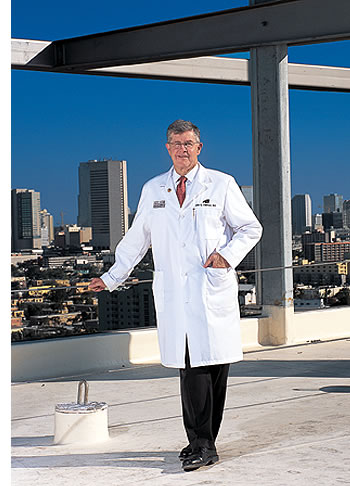‘The Best Is Yet to Come’
![]() ndividuals
and institutions from time to time need renewal—that’s what
a change in leadership is all about. While I have mixed emotions as I
prepare to move on after ten years as dean of the Miller School of Medicine,
I am confident that the school is well positioned to move to the next
level.
ndividuals
and institutions from time to time need renewal—that’s what
a change in leadership is all about. While I have mixed emotions as I
prepare to move on after ten years as dean of the Miller School of Medicine,
I am confident that the school is well positioned to move to the next
level.
 When
the American Board of Ophthalmology approached me about becoming executive
director, I decided to take a look at the opportunity because I’m
young, I’m in good health, I’m first and foremost an ophthalmologist,
professionally—and I thought the time was right for a change in
school leadership. Ten years is a long time to serve as dean, especially
of a large and complex institution such as ours; the average tenure for
deans is closer to three years. The accomplishments of the past ten years
will best be judged by the progress that occurs in the next ten years,
and there are signs all around us that the next decade will be spectacular
for the Miller School.
When
the American Board of Ophthalmology approached me about becoming executive
director, I decided to take a look at the opportunity because I’m
young, I’m in good health, I’m first and foremost an ophthalmologist,
professionally—and I thought the time was right for a change in
school leadership. Ten years is a long time to serve as dean, especially
of a large and complex institution such as ours; the average tenure for
deans is closer to three years. The accomplishments of the past ten years
will best be judged by the progress that occurs in the next ten years,
and there are signs all around us that the next decade will be spectacular
for the Miller School.
If you haven’t visited the campus recently, you would be astounded by the changes. Daily, I try to walk through the Schoninger Research Quadrangle in a section of campus that used to be nothing but asphalt. I see students, faculty, and staff eating lunch, having small conferences, and enjoying the beautiful surroundings and incomparable South Florida weather.
![]() New construction for clinical research, basic science
research, and a clinical practice building and hospital gives us the
opportunity to provide
excellent facilities for current faculty and for future faculty who,
together, will help us achieve our potential. Thanks to a remarkable
investment by the University and its community and philanthropic partners,
the total research space on the medical campus will grow to nearly two
million square feet.
New construction for clinical research, basic science
research, and a clinical practice building and hospital gives us the
opportunity to provide
excellent facilities for current faculty and for future faculty who,
together, will help us achieve our potential. Thanks to a remarkable
investment by the University and its community and philanthropic partners,
the total research space on the medical campus will grow to nearly two
million square feet.
The new University hospital will, for the first time, provide our clinical faculty with a state-of-the-art patient care facility, accommodating virtually all clinical disciplines under the same roof. The hospital will provide an attractive front door to the medical campus, strengthening our relationship with Jackson Memorial Hospital by facilitating patients’ access to the medical center.
The programmatic changes—such as the dramatic revision of the medical curriculum and our initiative to grow the research enterprise—will continue to be measured by the parameters all academic medical centers are judged by, including NIH funding and an emphasis on translational research. The Miller School of Medicine is committed to continuing excellence in areas that are already well recognized and to achieving excellence in other areas.
In recent months I have received honors from the Dade County Medical Association, the Greater Miami Chamber of Commerce, and the University of Miami. I am grateful for those acknowledgements. But organizational achievement must occur through the combined effort of every member. It is this hard work by our faculty, staff, and students that has moved the school forward. The University’s commitment to new facilities, combined with the magnanimous gift of the Leonard M. Miller family, has provided us with the building blocks to climb to the next level.
As I move on to a new opportunity while remaining on the UM faculty, I express my gratitude to the University administration—particularly President Edward T. Foote and President Donna E. Shalala—to the University’s Board of Trustees, to leaders of the medical school and Jackson Memorial Hospital, to our outstanding faculty, students, and staff, to our alumni and our friends. I appreciate your support, your energy, and your complete dedication to the mission of our School of Medicine.
I am excited as I contemplate the future of our medical school. Without a doubt, the best is yet to come.